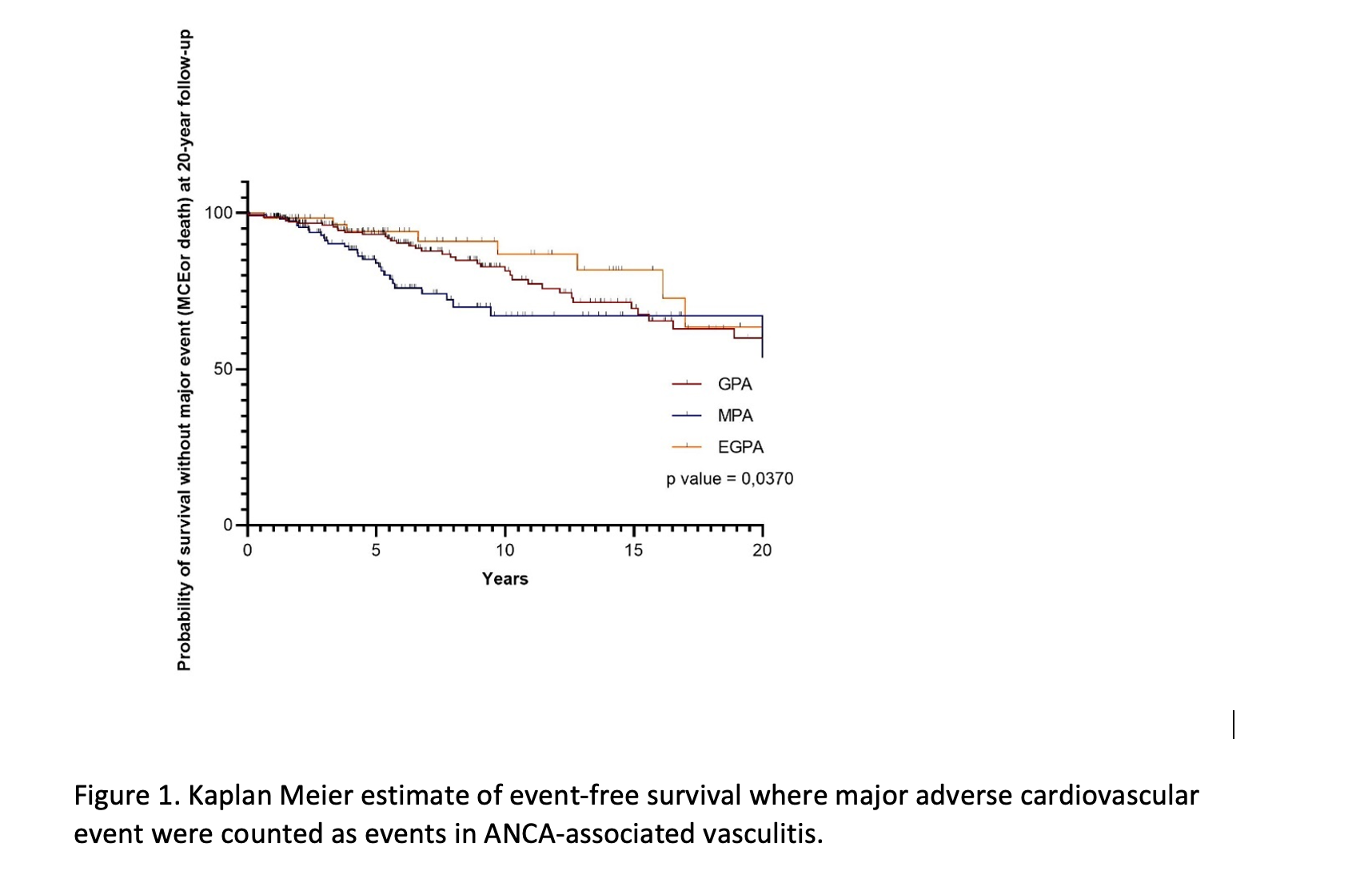Session Information
Date: Tuesday, November 14, 2023
Title: (2370–2386) Vasculitis – ANCA-Associated Poster III: Biomarkers & Renal Outcomes
Session Type: Poster Session C
Session Time: 9:00AM-11:00AM
Background/Purpose: The aim of this study was to investigate the risk of major adverse cardiovascular events (MACE) in patients with ANCA-associated vasculitis (AAV).
Methods: We conducted a retrospective study using the ANCA-associated vasculitis Toulouse cohort (AAVT). The incidence of MACE, defined as myocardial infarction (MI) and/or stroke and/or death, as well as survival, were compared between groups using the Chapel Hill Consensus Conference classification criteria. We also applied Cox regression models adjusted for traditional cardiovascular risk factors and sex to assess the risk of MI, stroke and MACE occurrence.
Results: A total of 454 patients were included, including 266 (50%) with granulomatosis with polyangiitis (GPA), 167 (37%) with microscopic polyangiitis (MPA), and 61 (13%) with eosinophilic granulomatosis with polyangiitis (EGPA). Of these, 249 (55%) were men and 205 (45%) were women. The mean age at diagnosis was 61 (SD: 16.49) years, and the mean follow-up duration was 7.185 (SD: 6.72) years. We identified 19 MI and 13 strokes during the study period. The incidence rate of MACE was 23.77 per 1000 patient-years in the GPA group, compared to 35.51 per 1000 patient-years in the MPA group and 20.03 per 1000 patient-years in the EGPA group. The mean time to occurrence of a MACE was 8.07 (SD: 6.19) years in the GPA group, 4.59 (SD: 4.63) years in the MPA group and 13.58 (SD: 11.51) years in the GEPA group (p=0.0001). At 5 and 10 years from diagnosis, the probability of survival without MACE was 93.3% and 81.57%, respectively, in the GPA group, 83.98% and 67.15% in the MPA group, and 94.33% and 86.83% in the EGPA group (p=0.037). The incidence rate of MI was 4.10 per 1000 patient-years in the GPA group, compared to 8.44 per 1000 patient-years in the MPA group and 5.37 per 1000 patient-years in the EGPA group. The mean time to occurrence of an MI was 3.72 (SD: 5.74) years in the GPA group, compared to 3.04 (SD: 2) years in the MPA group and 7.52 (SD: 5.28) years in the EGPA group (p=0.0001). At 5 and 10 years from diagnosis, the incidence of MI was 2% and 3%, respectively, in the GPA group, 4% and 5% in the MPA group, and 2% and 5% in the EGPA group (p=0.48). The incidence rate of stroke was 4.08 per 1000 patient-years in the GPA group, compared to 5.26 per 1000 patient-years in the MPA group and 1.73 per 1000 patient-years in the EGPA group. The mean time to occurrence of a stroke was 7.19 (SD: 5.11) years in the GPA group, compared to 3 (SD: 2.14) years in the MPA group and 17.83 (SD not applicable) years in the EGPA group (0;0001). At 5 and 10 years from diagnosis the incidence of stroke was 1% and 2% respectively in the GPA group, 2% and 3% in the MPA group, and 0% in the EGPA group (p=0;49).
Conclusion: Patients classified as MPA appear to be at higher risk of MACE and have a lower probability of MACE-free survival.
To cite this abstract in AMA style:
Idoate J, Mourguet M, Villeneuve T, Prevot G, Guilleminault L, David R, Faguer S, Huart A, Chauveau D, Alric L, Michaud M, Sailler L, De Almeida Chavez S, Mouchon E, Lairez O, Pugnet G. Risk of Major Adverse Cardiovascular Events in ANCA-associated Vasculitis [abstract]. Arthritis Rheumatol. 2023; 75 (suppl 9). https://acrabstracts.org/abstract/risk-of-major-adverse-cardiovascular-events-in-anca-associated-vasculitis/. Accessed .« Back to ACR Convergence 2023
ACR Meeting Abstracts - https://acrabstracts.org/abstract/risk-of-major-adverse-cardiovascular-events-in-anca-associated-vasculitis/

